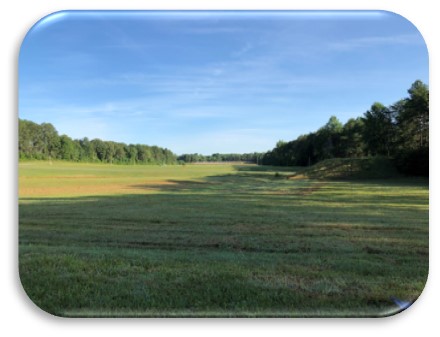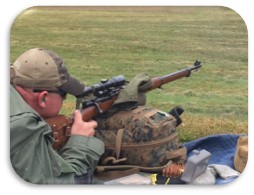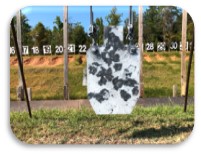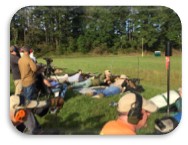Range Description
Range 4 aboard Marine Corps Base Quantico (MCBQ) is a known distance (KD), 1000-yard range used for precision rifle events sponsored by the Quantico Shooting Club (QSC). Target placement is permitted between 100 and 1000 yards
Range 4 has many unique features making it ideal for precision rifle events:
- 50 distinct, marked shooting positions each with its own target carriage system for KD targets in the pit area
- Shooting positions clearly marked in 100-yard increments
- A top berm where steel target systems can be placed
- A rear impact area where clay targets can be placed for a total distance of 1035 yards
QSC sponsored precision rifle events include 1000-yard fixed target and multi-yard target disciplines such as 300/600/1000 yards. From time-to-time, QSC will sponsor special precision rifle activities like Know Your Limits (KYL – steel targets at a fixed range decreasing in size) and hunting challenges (hitting a specific spot on an animal target).
The QSC does not sponsor recreational fire events on Range 4.
Please note the following regarding Range 4:
- Although .338 Lapua is authorized for use on Range 4, the Range Safety Officers (RSOs) do not know if airspace for .338 Lapua can be cleared until they physically occupy the range on the day of the shooting event. Therefore, it is strongly advised shooters bring another rifle / caliber in the event .338 Lapua is blocked for that day
- Be advised MCBQ Range Control may place further restrictions on ammunition eligibility on Range 4 at any time for any reason.
Range Operations for Range 4 Aboard MCBQ Operated by the QSC
For precision rifle shooting events:
- Range 4 shooters meet at Gate 7 on Willis Road and wait for the RSO team to open the gate to access the range pits
- The QSC RSO team generally opens Range 4 at 0715 hours with target setup and placement concluding no later than 0745 hours.
- Once target placement is concluded and the Range 4 pits are confirmed cleared by the RSO team, all shooters will be instructed to drive to the parking area above the 1000-yard firing line
- Shooters will unload their gear and proceed to the corresponding shooting position for their target. For example, if the shooter placed their target on position 30, the shooter’s gear should be placed where the position 30 ground marker is located on the 1000-yard firing line
- The range goes hot at approximately 0800 hours
- A brief cease fire is called around 0940 hours for target adjustment and to permit new shooters to place targets. Live fire resumes around 1000 hours. There are generally no additional cease fire / cold times until the range is closed
- Range 4 usually closes for the day no later than 1300 hours, however it’s at the RSOs discretion to make schedule adjustments as needed.
IMPORTANT NOTE: Depending on the specific precision shooting activity for the day, this schedule may be modified. It is the shooter’s responsibility to check the range notes for details prior to heading to a Range 4 event.
Unless otherwise specified in the range notes or by the RSO team:
- Lanes 1 thru 19 are reserved for paper targets on KD frames
- Lanes 20 thru 29 are reserved for special targets and RSOs who spot for those specific challenges
- Lanes 30 thru 50 are reserved for steel targets
Enforced range operation rules include, but may not be limited to the following:
- Firearms must be cased when moving them between the shooter’s vehicle and the Range 4 firing line
- All firearms must remain cased until after the safety briefing is complete and the RSOs have communicated the firing line is hot
- Under no circumstances will shooters handle firearms when the firing line is cold
- All weapons will always be pointed straight down range
- Empty Chamber Indicators (ECIs) are mandatory for all uncased weapons not being fired on the Range 4 firing line
General Range Safety Rules for All Ranges Aboard MCBQ Operated by the QSC:
- Always treat weapons as if they are loaded
- Keep your fingers off the trigger until you are ready to shoot
- Always point your weapon in a safe direction
- Always know what’s behind your target and backstop
The QSC and its members are guests aboard MCBQ. We are indeed fortunate to have access to the fine ranges on the Calvin Lloyd Range Complex. As such, the QSC takes range and firearms safety very seriously. Any violation of published safety rules or RSO commands may result in the shooter’s immediate removal from the firing line and range complex for the day. All safety violations are fully documented and retained on file per QSC and MCBQ procedures. Repeated safety violations will result in the shooter’s expulsion from the QSC.
Shooter’s Obligations
- Shooters will listen to and obey all commands issued by the QSC Range Safety Officers (RSOs). Their commands and request are not negotiable
- Shooters must bring their own targets, target backers, target stands, target stand supports and fasteners. For those shooting at paper targets on Range 4, the QSC has KD frames available for use by members and guests
- Shooters participating in Range 4 precision shooting events must have their target systems perfected prior to arriving at the range. Shooters are expected to be prepared for a quick install and take down. To quote a famous QSC member “you don’t have time to fool around and build the Taj Mahal.”
- Ear and eye protection is required on all ranges aboard MCBQ operated by the QSC and must be provided by the shooter
- Food, hydration and bug spray are the responsibility of the shooter
- At the end of the day, all shooters must police their brass and remove all trash before exiting the range
- Before heading to the range, shooters are responsible for:
- Checking the QSC club calendar for last-minute updates to the day’s shooting event
- Reading and understanding the RSOs range notes linked in the QSC club calendar for the day of the shooting event
- Shooters must always follow safe firearms practices while on ranges aboard MCBQ operated by the QSC
Target and Target Systems Requirements
- Targets are limited to paper, wood, plastic and approved ballistic steel.
- The following targets are not permitted on any range aboard MCBQ operated by the QSC:
- Targets that create shards, such as glass
- Reactive or explosive targets, such as Tannerite
- Gimmick-like targets such as dueling trees, Texas Stars or spinners
- All ballistic steel targets must be:
- Constructed of AR500 steel with a minimum thickness of 3/8”
- Mounted or hung with a forward cant or the ability to react / rebound with a bullet hit so as to deflect bullet fragments towards the ground
Minimum Engagement Distances for Ballistic Steel Reactive Targets (SRTs)
The following are the MCBQ published minimum distances for engaging SRTs on Range 4:
- Pistols, Braced Pistols and Shotgun – Not permitted on Range 4 for QSC-sponsored precision shooting events
- 5.56mm / .223 Ball - 110 yards
- 7.62mm / .308 Ball - 165 yards
- 300 Win Mag – 410 yards
- .338 Lapua – 410 yards
- .50 BMG – 410 yards
- 6.5 Creedmoor – 410 yards
- 6.8mm – Not authorized for SRTs / Paper targets only
IMPORTANT NOTE: The minimum engagement distances listed above are hard and fast rules published by MCBQ Range Control. Exceptions cannot be made by the OIC or RSO team, so do not ask!
Updated April 20, 2025
Please enjoy these videos that show some activities on Range 4:
- The first offers hints, tips and advice for a successful range day and applies to all QSC ranges
- The second is a a long time, 70+ year old member firing their 50BMG
- Next is a first round hit on an 8" Milk Jug, which is part of the 1,000 yard "Milk Jug" challenge of running your bolt, not your mouth on Range 4. The video was an initial attempt using a scope camera that was adjusted to too high a magnification, but you get the idea.
- Lastly is a cold bore, first round hit at 1,000 yards with a 300PRC on a 2/3rd IPSC target (12"x20"), that's what Range 4 is all about





